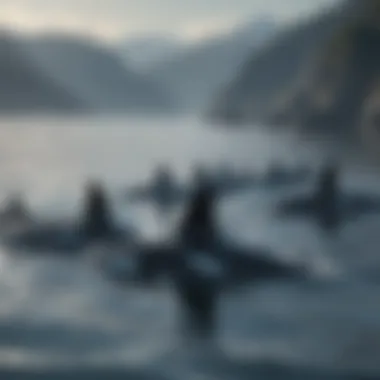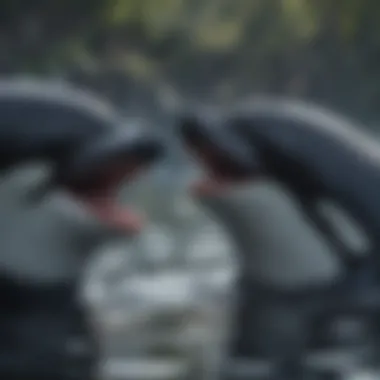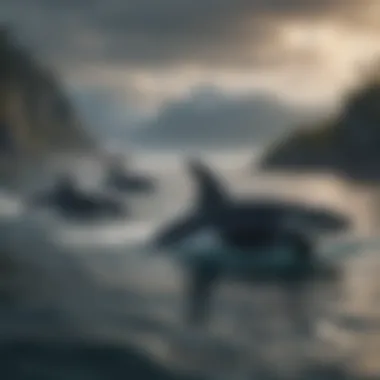Understanding Orca Groups: Social Structures of Apex Predators


Intro
Orcas, often called killer whales, stand as the ocean's apex predators. Understanding their groups, known as pods, provides insight into their complex social structures, behaviors, and the roles they play within marine ecosystems. Social interactions among orcas engage a wide array of communication methods, both vocal and physical. Such dynamics not only contribute to their hunting success but also influence their conservation status.
In this article, we will explore various aspects of orca pods, their fascinating social lives, communication styles, and hunting strategies. Moreover, we will discuss their environmental impact and why it is essential to protect these intelligent creatures. Through this understanding, we aim to create awareness about the ecological importance of orcas and foster appreciation for their existence among young readers, parents, and educators.
Nature Topic Overview
Orca society is hierarchical and multifaceted. Typically, pods consist of family members with matriarchs leading the group. This social structure impacts their behaviors, relationships, and hunting strategies. Communication plays a critical role within pod dynamics, as orcas utilize distinct vocalizations specific to each group. Each pod has its own dialect that reflects their unique identity.
Orcas have strong social bonds. Mothers nurture their calves, teaching them essential skills for survival. Cooperation during hunts is key. Supporting one another leads to efficient hunting practices which ensures access to food sources.
Through understanding orca groups, we can appreciate not just their behaviors but also the reasons behind their conservation. The health of marine ecosystems hinges on the balance maintained by apex predators like orcas. Thus, recognizing their vast significance is vital in fostering respect for ocean life.
Fun Facts and Trivia
- Orcas are not actually whales; they are part of the dolphin family.
- The longest orca recorded lived up to 90 years.
- Each pod has a unique dialect and can identify each other's sounds.
“Orca pods can communicate over vast ocean distances using low-frequency calls.”
Visual aids such as illustrations of various orca pods with their ranges can enhance the learning experience and appeal to children.
Wildlife Explorations
Different species of orcas inhabit various regions of the world, displaying a variety of behaviors and preferences. Many live in colder waters, while others are found in warmer regions. Understanding the diverse habitats of orcas can intrigue young minds.
Features related to species interactions in the ecosystem are significant too. For instance, orcas may even hunt seals or even whales, displaying their prowess as predators in manipulating ocean populations. Kids can learn how these relationships ripple through the ecosystem.
Quizzes on different populations of orcas can be engaging.
Environmental Awareness
Conservation efforts are crucial for these remarkable predators. Overfishing, pollution, and climate change directly affect orca populations. Raising consciousness about these factors can guide young readers toward valuing ocean conservation.
Tips for children to help protect the ocean include:
- Reduce Plastic Use: Opt for reusable bags and bottles.
- Support Clean-ups: Engage in community clean-up initiatives.
- Learn & Share: Promote awareness about ocean conservation among friends.
DIY Nature Activities
Hands-on projects ignite curiosity and reinforce topics discussed. Activities might include:
- Create Your Own Orca: Utilize paper plates and paints to craft a life-like orca model.
- Sound Chart: Make a chart to record different orca sounds, mimicking their communication traits.
- Nature Walk: Conduct a local expedition, mapping sea life changes influenced by human activities.
By fostering an interest from these diverse activities, readers are inspired to appreciate and protect their natural world. Through nurtured curiosity and engagement, we can jointly enable the protection of orcas and marine ecosystems for future generations.
Intro to Orcas
Orcas, also known as killer whales, are fascinating marine mammals with complex social structures. Understanding orcas is important for various reasons. Firstly, they are highly intelligent animals that showcase intricate group behaviors. This article explains why studying these behaviors is vital for marine biology and conservation efforts.
What Are Orcas?
Orcas, or killer whales, are the largest members of the dolphin family. They live in oceans worldwide. These animals are easily recognizable, thanks to their striking black-and-white coloration. Orcas are apex predators; they sit atop the marine food chain. This means they have few natural enemies. They often hunt seals, penguins, and even whales. The adaptability in diet helps orcas thrive in different oceanic environments.
There are different types of orca groups, known as pods. These pods can range in size from a small family unit of a few individuals to larger groups of over 30 members. The composition of a pod frequently depends on geographical location and available prey. Communication plays a crucial role, allowing orcas to coordinate hunting strategies and maintain social bonds.
The Importance of Studying Orcas
Studying orcas provides us with valuable insights into their behavior and the ecosystems they inhabit. Here are some reasons why understanding orcas matters:


- Ecological Indicators: Orcas are important indicators of ocean health. Changes in their behavior or population patterns can signal issues in marine ecosystems.
- Cultural Learning: Orcas exhibit cultural learning, where skills and knowledge are passed down through generations. Studying this helps reveal aspects of animal intelligence.
- Conservation Awareness: Learning about orcas raises awareness about the challenges fauna faces today. This awareness is crucial in promoting conservation initiatives.
In summary, comprehending orcas’ social structures and their role in marine ecosystems is essential. They are not only vital to the oceanic food web but also symbols of conservation. By understanding their needs and behaviors, we can better foster our commitment to protecting these magnificent creatures.
The Social Structure of Orcas
The social structure of orcas, or killer whales, plays a critical role in understanding these complex and intelligent marine mammals. Their group dynamics reveal much about their behaviors, communication, and survival tactics. Orcas are known for their sophisticated social organization, which enhances cooperation and social learning. This article aims to illuminate the high level of camaraderie seen within pods and how this social structure affects foraging, reproduction, and overall wellbeing.
Understanding Orca Pods
Orca pods are family groups that consist of close relatives, typically maternal family units. Each pod may consist of a few to several dozen individuals. The social bonding among members shows in their caring behaviors and cooperative hunting techniques. They rely on strong social ties for various life activities. The nurturing environment seen in pods fosters emotional connections, essential for their survival. Understanding the characteristics of these pods is crucial because the dynamics influence individual health and subsequent generation validation.
Types of Orca Groups
Different types of orca groups exist, showing remarkable variations in behaviour, feeding habits, and social interactions. These are Resident Pods, Transient Pods, and Offshore Pods.
Resident Pods
Resident Pods are a well-studied and prominent type. These pods are characterized by their residing in specific areas, often sticking to coastal waters. They exhibit strong social bonds and often the same family members stay together for long periods. The key characteristic of Resident Pods is their lifestyle: they primarily feed on local fish, which contributes to their steady population.
A distinguishing feature of Resident Pods is their vocalizations. They have unique sounds that form their social identity. However, this consistency can make them vulnerable to local environmental changes. Thus, the behavior of Resident Pods benefits the overall understanding of habitat conservation.
Transient Pods
Transient Pods differ significantly from their resident counterparts. They are known for their mobility, often traveling large distances in search of different prey. This type of pod primarily hunts other marine mammals and showcases more solitary behavior in comparison.
Transient Pods possess a crucial characteristic: their stealth and cunning. This contributes aesthetically to the orca's hunting strategy, emphasizing adaptability. A downside is that their nomadic lifestyle can lead to isolation from familial units, risking younger members' socialization. Such understanding highlights the fragile nature of connections within orca structures.
Offshore Pods
Offshore Pods fill yet another niche within the orca social structure. Found farther away from the coastline, these pods often occupy deeper waters. They are less studied than Resident and Transient Pods. One interesting characteristic is their size. Offshore Pods tend to be larger and can include several family groups.
A unique feature of Offshore Pods is their feeding on deep-water species, which influences their hunting culture. While they appear robust and might look more stable concerning their habitat, their limited researched presence raises questions regarding their health and ecosystem influence. Through Offshore Pods, researchers can gain insights into ecological adaptability among orcas and constraints tied to ocean structure.
Understanding the differences in social structure among these three types of orca pods gives high awareness of the behaviors and life choices crucial to their survival within unique marine environments. Their differing strategies enrich the overall study of orcas and the ecosystem in which they thrive.
Communication in Orca Groups
Understanding how orcas communicate reveals insights into their social behaviors. This topic is important as communication plays a key role in maintaining the unique social structures within orca pods. Effective communication ensures that pod members coordinate their activities, enhance social bonds, and teach each other important survival skills.
Orcas display a remarkable range of communication methods including verbal and non-verbal cues. This intricate system enables them to convey various messages, from alerts about predators to cooperative hunting strategies. Studying these communication methods can also offer valuable lessons about social interaction in both marine and terrestrial contexts, especially for younger audiences looking to understand animal behavior and nature's complexities.
Vocalizations and Sounds
Orcas utilize sophisticated vocalizations that are crucial for their interactions. Each pod has its own set of unique sounds known as dialects. These sounds serve multiple purposes. They function as a means of identification among members of the pod. For example:
- Echolocation: Orcas use sound to locate prey and navigate through the ocean. It is like using sonar to detect objects.
- Social sounds: These sounds help in maintaining the social structure within pods. Calls can link members together or indicate warnings.
- Foraging calls: Certain vocalizations can signal to other orcas about available food sources.
Vocalizations can differ according to the region and the specific community within the pod. This adaptation aids in social cohesion and improves hunting efficiency.
Non-Verbal Communication
In addition to vocalizations, orcas communicate through body language and movement patterns. This type of communication is vital in conveying emotions and intentions among group members. Common forms include:
- Breaching: Jumping out of the water can show excitement or alertness.
- Spyhopping: This behavior involves popping their heads out of the water, allowing orcas to observe their surroundings. It also serves as a way to communicate to other pod members that they are aware of their environment.
- Posture: The position of body and fins can signal various moods, from relaxation to agitation.
Each method of non-verbal communication reinforces group unity and helps with survival. The combination of both vocal and non-verbal forms strengthens the interactions within orca pods, playing a central role in how these intelligent creatures coexist in their vast ocean habitat.
Effective communication serves as the backbone of orca social structures, enabling cooperation and mutual support that perpetuates their species.
As you can see, understanding the communication in orca groups provides a foundational knowledge of their social dynamics. Recognizing how orcas send and receive messages enhances our appreciation for their complex social lives.


Orca Hunting Strategies
Understanding how orcas hunt is key to appreciating their complex social structures and behaviors. Orcas are apex predators, meaning they sit at the top of the food chain in their environment. This title carries responsibility, as their hunting strategies play a crucial role in maintaining balance within marine ecosystems. The study of orca hunting shows us how their cooperation and adaptability directly affect their success and survival.
Cooperative Hunting Techniques
Orcas are known for their ability to work together in groups to increase their hunting success . This cooperative hunting, often referred to as social hunting, showcases their advanced communication skills and social bonds. They use a variety of techniques based on the type of prey they are targeting.
Instances of teamwork include:
- Herding Fish: Sometimes orcas will circle schools of fish, pushing them close together. This strategy confuses the fish and makes them easier to catch.
- Beach Rubbing: Some pods have been observed intentionally beaching themselves to catch seals and other small marine mammals. This behavior requires precise timing and relies heavily on the trust among group members.
- Bubble Net Feeding: When targeting certain fish, orcas create a circle of bubbles that encircle the prey. This method traps the fish in place, allowing them to swim in for the catch.
This cooperation is not just about catching a meal; it reinforces relationships within the pod. When young orcas witness and participate in these hunting methods, they learn essential skills needed for survival.
Prey Selection and Adaptations
Selecting the right prey is vital for successful hunting. Depending on the pod, orcas may focus on different kinds of marine life, including larger mammals or schools of fish. Their prey choices depend on factors such as location, availability, and group experience.
Types of Prey:
- Fish: Under this category, some common catches are salmon and herring that are generally found in colder waters.
- Seals and Sea Lions: These marine mammals become prime targets, particularly for groups skilled in beach rubbings.
- Whales: Orcas have been observed hunting larger whale species. This is often done by pods working together to fatigue and isolate the target.
Orcas exhibit remarkable physiological adaptations that facilitate their predatory lifestyle. Their size, speed, and echolocation capabilities allow them to navigate their environment effectively and optimize their hunting tactics.
Did You Know? Orcas have complex social structures, inspiring various cultural interpretations around the world.
Skills learnt during the hunting process contribute to an orca's long-term survival. Both young and mature members of a pod learn through observation and active participation, ensuring that critical knowledge is passed down through generations. The studying of these hunting strategies shows not only the effectiveness of orca pods but also underlines the harmonized effort in maintaining their population and interactions with other marine species.
Social Learning Among Orcas
Studying how orcas learn from each other reveals key insights about their social structure. Social learning is fundamental for the survival of these magnificent creatures. By passing knowledge within their pods, orcas can adapt more easily to the changing environments they inhabit. Each pod develops its own techniques and customs, ensuring a greater chance of success in hunting and navigation.
Knowledge Transmission in Pods
Orcas rely on their family structures to transmit knowledge. This process has been observed in how they teach their young to hunt. The young orcas often watch and mimic the actions of adult orcas. For instance, they may follow their mothers during a hunt, learning how to work together. Each member plays a role, whether it is signaling when to strike or coordinating movements to herd prey. This learned behavior enhances the effectiveness of the hunt, reflecting the pod’s collective experience.
- Observation: Young orcas studying adults.
- Mimicry: Copying successful hunting techniques.
- Reinforcement: Celebrating successful hunts solidifies learning.
Additionally, the transfer of knowledge happens not just during hunts. Young orcas soak in everyday activities and customs, including social interactions, vocalizations, and movements unique to their pod.
Social learning shapes the identity of the pod. Each group has distinct behaviors that set them apart.
Cultural Variability in Orca Groups
Different pods of orcas can exhibit varying behaviors, often termed as cultural variability. This cultural difference contributes to how they hunt, interact, and communicate. Resident pods may have elaborate hunting strategies and vocalizations tailored for specific prey. In contrast, transient pods may demonstrate behaviors suited for their specific predatory skills.
Some interesting aspects include:
- Hunting Strategies: Each pod might use different techniques based on local prey availability.
- Vocal Dialects: Orca pods develop unique sounds, almost like different languages.
- Traditions: Customs may change over time as pods adapt to new challenges, often influenced by younger orcas who learned different skills.
Overall, social learning is not merely a way for orcas to survive. It serves as a robust system allowing orca pods to thrive in the vastness of their marine environments. Such learning and cultural adaptability showcase the advanced social structures of these apex predators.
The Role of Orcas in Marine Ecosystems
Orcas play an essential role in maintaining the health and balance of marine ecosystems. As top predators, their presence influences the population dynamics of various marine species. Understanding the role of orcas in their environments helps us recognize their ecological significance and the impact they have on other marine life.
Top Predators and Their Impact
Orcas, often referred to as killer whales, sit atop the marine food chain. Their hunting practices regulate populations of prey species, which includes fish and larger marine mammals. By actively controlling these populations, orcas help maintain a healthy balance in the ecosystem. Without such predation, certain prey might become overly abundant, leading to resource depletion and habitat damage.
- Impact on Fish Populations: Specific groups of orcas are known to target particular fish species. For example, resident pods often specialize in salmon, contributing to the health of fish populations by keeping them in check.
- Balance Between Species: The removal of excess prey assists healthier populations of competing species. They also assist in ensuring genetic diversity within these populations.


Moreover, orcas demonstrate a behavior called 'asocial salmon', which leads to significant foraging. This behavior means they focus hunting efforts on specific fish behaviors or feeding strategies. Such strategies allow them to capture salmon nearly effortlessly, avoiding overfishing any specific area.
Interactions with Other Marine Species
The complex relationships orcas maintain with other marine animals stretch beyond mere predation. They influence a multitude of dynamics in the ocean.
- Competition and Cooperation: Other predator species interact with orcas as both competitors and cooperators in the search for food. For instance, they sometimes share hunting grounds with other apex predators, creating an intricate web of interaction and competition.
- Ecosystem Engineers: By controlling fish populations, orcas play a direct role in supporting seabirds, seals, and other marine species that share habitats and consume overlapping prey.
Relationship between orcas and their environment exemplifies interdependence in ecosystems, reminding us that anytime one piece is removed or damaged, the web may unravel in some form.
Orcas act as indicators of ocean health, reflecting the state of marine ecosystems and the impacts of human activities.
As apex predators, orcas influence their environment in a variety of significant ways. It is crucial to consider their role in marine conservation. Protecting orcas works hand-in-hand with preserving the intricate balance of life beneath the waves.
Challenges Facing Orca Populations
Understanding the challenges facing orca populations is essential for comprehending the complexities of their environment and the implications for their survival. Orcas, as apex predators, play a critical role in marine ecosystems. Yet, various factors threaten their existence, obstructing the delicate balance necessary for healthy ocean habitats.
Threats to Orca Groups
Orcas face numerous threats that impact their populations. Some key issues include:
- Pollution: Contaminants in the ocean, such as heavy metals and plastics, pose risks to orca health. These pollutants accumulate in the food web, affecting their prey and ultimately harming the orcas themselves.
- Climate Change: Alteration of ocean temperatures and food distribution affects the availability of prey species. As their hunting grounds diminish, orcas must migrate longer distances to locate food.
- Boat Traffic: Increased marine traffic can lead to physical strikes and stress for orcas. Noise pollution from vessels disrupts their communication, impairing their social interactions and hunting methods.
- Overfishing: Depletion of fish stocks reduces food availability for certain orca populations, especially residents that rely heavily on specific prey fish such as salmon.
It is vital to recognize these threats to enact suitable measures for orca protection.
Conservation Efforts and Initiatives
Conservation organizations and governments implement various measures to protect orca populations. A few important initiatives include:
- Marine Protected Areas: Establishing designated zones restricts activities such as fishing and boating, promoting safer habitats for orcas to thrive while supporting local ecosystems.
- Legislation: Numerous countries enforce laws to regulate pollution and manage fisheries. These policies aim to reduce harmful impacts on orca populations and their environments.
- Public Awareness Campaigns: Educating communities about orcas’ importance supports local conservation efforts. Raising awareness contributes to forged relationships between humans and marine life, promoting responsible behaviors.
- Research and Monitoring: Continual monitoring of orca populations helps scientists understand trends and make informed decisions on conservation strategies. They utilize tags and acoustic monitoring to study movements and social structures.
By engaging in these conservation efforts, we can address the threats facing these majestic creatures, inspiring collective action toward their enduring survival.
Educational Resources for Learning About Orcas
Educational resources about orcas serve a crucial role in building understanding and appreciation of these complex marine mammals. Learning about orcas extends beyond basic facts; it encompasses their social structures, communication behaviors, and ecological significance. For young readers, parents, and teachers, these resources can also inspire conservation efforts. By providing engaging and informative content, they effectively stimulate interest and curiosity about our ocean's ecosystems.
There are several categories of learning tools available for those who wish to explore orca biology more deeply. These tools can cater to different learning styles, from visual and auditory methods to interactive experiences.
Books and Documentaries
Books and documentaries about orcas can open the door to a fascinating world inhabited by these intelligent animals. They offer vivid imagery and well-researched narratives that allow readers and viewers to witness orcas in various contexts.
Some notable books include the beautifully illustrated Orca – The Whale Called Killer by Niki Alling and Beyond Boundaries: The Journey of the Orca by Wanda H. Jones. Documentaries such as Blackfish and The Dolphins: The Sound We Can’t Hear provide in-depth examinations of orca behavior, highlighting ethical issues surrounding captivity and conservation.
These resources present facts clearly and can encourage discussions. They help explain important concepts like pod structures, hunting strategies, and the impact of human activities. Finding trusted sources is vital when exploring these topics, as several materials might include outdated information or poorly researched claims.
To engage children effectively, many books include stunning artwork and age-appropriate storytelling. Educators and parents should select materials that maintain accurate information while igniting a sense of wonder. Incorporating these resources into lesson plans can support understanding and a love for marine biology.
Interactive Learning Tools
Interactive learning tools are essential for hands-on engagement. Technology has provided unique opportunities to learn through apps and online platforms dedicated to orca education. Features of these tools often include games, quizzes, and virtual tours of their habitats.
Applications like Orca Explorer offer detailed data about orca pods, about different species, and insertion tasks. Websites such as National Geographic Kids provide interactive articles filled with multimedia experiences that attract young minds.
These resources enhance learning experiences and can serve as a bridge for children to develop deeper knowledge.
When utilizing interactive tools, educators must take care to verify the credibility of websites and applications. Falso information can lead to misconceptions.
In summary, educational resources about orcas must be chosen wisely to enrich understanding. Books, documentaries, and interactive tools expand the horizon of knowledge while fostering a conservation mindset. Using these tools effectively can transform curiosity into commitment, sparking a lasting interest in marine life among children and adults alike.
The End: The Future of Orcas
Orcas are essential components of marine ecosystems. Their status as apex predators means their presence has significant effects on the marine environment. The future of orcas hinges on understanding their social structures, conservation needs, and the roles they play in their habitats.
One vital focus is responsible stewardship. As human actions continue to impact the oceans, awareness of sustainable practices becomes crucial for the protection of orca populations. By implementing conservation strategies, humans can assist orcas in maintaining their populations and environments.







